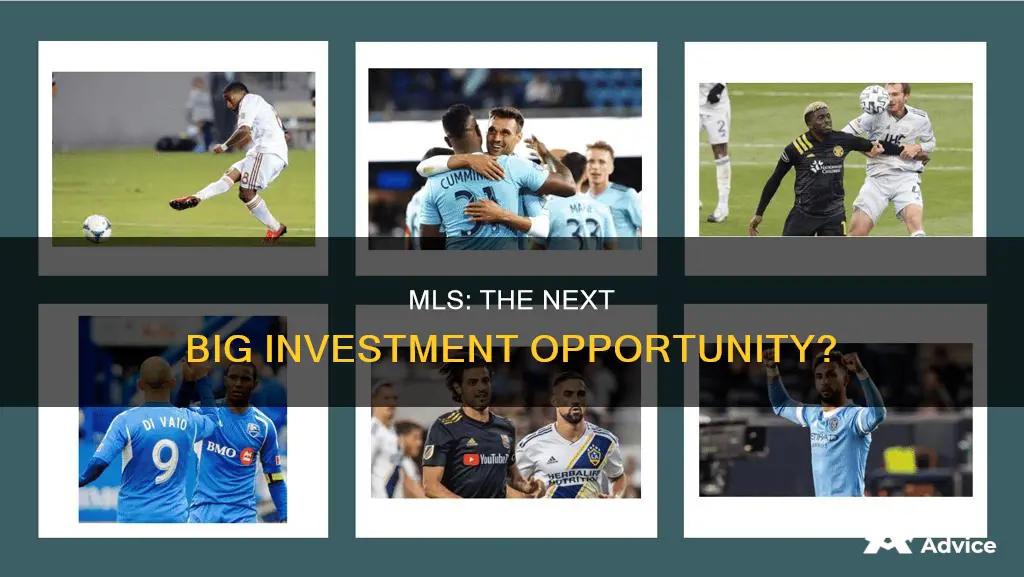
Major League Soccer (MLS) is a men's professional soccer league sanctioned by the United States Soccer Federation. It is the most recent in a series of men's premier professional national soccer leagues established in the United States and Canada.
MLS teams don't have owners in the classic sense. They have investor-operators who are financially invested in the same business entity, Major League Soccer, LLC, and succeed and fail together. They all made their initial investment in the LLC, and they all receive a pro-rata share of the profits if and when MLS generates a profit.
MLS has a complicated business model. The league pays players to compete, and fans pay to watch in the stadium or via a cable package. The league has also created its own editorial arm, which creates articles, blogs, videos, podcasts, and recaps to keep fans engaged throughout the week.
MLS has also introduced various initiatives and rules intended to improve the quality of players while still maintaining the salary cap. The designated player (DP) rule, for example, allows teams to sign a limited number of players whose salary exceeds the maximum cap.
In 2022, MLS had the fourth-highest average attendance of the major professional sports leagues in the United States and Canada, with an average attendance of over 21,000 per game. The league has also seen its revenues increase while controlling costs. Television coverage and revenue have increased since the league's early years, and MLS has signed major sponsorship deals with companies like Adidas.
While MLS receives criticism for its relatively small player salary spend, it has managed to find a balance. The league is continuously growing its customer (fan) base while effectively containing this potentially explosive budget line. MLS knows that having higher-quality players will lead to increased attendance and viewership, which will improve all other revenue streams.
What You'll Learn
- The MLS is a single entity, with teams centrally owned by the league
- The league's centralised salary controls and tightly managed competitive rules ensure spending sprees don't bankrupt the league
- The MLS has a complicated business model, with investor-operators who are financially invested in the same business entity
- The league has a fixed membership and doesn't use a promotion and relegation process
- The MLS has a unique calendar, with the regular season running from late February or early March to October

The MLS is a single entity, with teams centrally owned by the league
The single-entity structure was necessary in the league's first ten years, as there were few investors and little financial backing. At one time, Phil Anschutz's AEG operated six MLS franchises, and Lamar Hunt's Hunt Sports operated three teams. To attract additional investors, the league made changes to the operating agreement between the league and its teams, such as granting operators the rights to a certain number of players developed through their club's academy system each year, and sharing the profits of Soccer United Marketing.
The league's single-entity structure has been the subject of legal challenges from players, who argue that it devalues their services and restricts competition. However, the courts have ruled that the MLS is a single entity and therefore incapable of conspiring with itself to restrain trade.
The single-entity structure allows the MLS to control player acquisitions and costs, and prevents teams from competing with one another for players. It also means that the league is responsible for most expenses, including player acquisition costs, salaries, benefits, salaries for league personnel, travel expenses, and insurance.
The MLS's centralised power and control over its teams have been key to its growth and survival in the saturated market of American sports.
Wellness Warriors: Who Invests in Health?
You may want to see also

The league's centralised salary controls and tightly managed competitive rules ensure spending sprees don't bankrupt the league
Major League Soccer (MLS) is a single-entity league, meaning that each team is centrally owned by the league and individually operated by investors. This structure allows the league to control costs and prevent overspending on player salaries, which could bankrupt the league.
MLS has a salary cap in place, which has been a feature of the league since its inception in 1996. The salary cap is designed to prevent unsustainable spending on player salaries and to maintain a competitive balance among teams. The salary cap has been legally challenged by players but was upheld in court, with the judge ruling that MLS, as a single entity, can lawfully centrally contract for player services and limit salaries.
In addition to the salary cap, MLS has introduced various other rules and initiatives to control spending and maintain competitive balance. These include the Designated Player Rule, which allows teams to sign a limited number of players whose salaries are exempt from the cap, and the use of allocation money, which can be used to sign players or "buy down" a player's salary cap hit.
MLS also has rules in place regarding roster sizes and substitutions, which further control team spending. Teams are limited to a maximum of 30 players on their first-team roster, with only 20 players eligible for selection for each game. Teams are allowed a maximum of five substitutions per game, with additional concussion substitutions available if needed.
The league also has strict rules regarding cautions and suspensions, with fines and suspensions levied against players and team officials for yellow card accumulations. This helps to maintain discipline and prevent excessive player absences, which could impact a team's performance.
Overall, MLS's centralised salary controls and tightly managed competitive rules ensure that spending sprees do not bankrupt the league. The league has strict mechanisms in place to control costs and maintain a level playing field, which has contributed to its financial stability and longevity.
Raisin in the Sun" Investors Reveale
You may want to see also

The MLS has a complicated business model, with investor-operators who are financially invested in the same business entity
The Major League Soccer (MLS) has a unique business model that sets it apart from other American sports leagues. Unlike these leagues, MLS is not structured as a legal cartel, but rather as a single entity where each team is owned by the league and operated by investor-operators. These investor-operators are financially invested in the same business entity, Major League Soccer, LLC, and share profits and losses. This means that they all made an initial investment in the LLC and receive a pro-rata share of the profits or losses.
The investor-operators are entitled to earn certain revenues directly for their respective teams. This includes revenues from local broadcast rights, merchandise sold in the stadium, local sponsors, and all parking and stadium revenue. However, they are required to send a portion of their revenue to MLS, such as 30% of ticket sales and between 25-44% of money earned through player transfer fees. MLS directly takes all revenue from national broadcast rights, league-level sponsorships, and online merchandise sales.
On the expense side, MLS pays all normal player salaries, as well as salaries covered under allocation money. The rest of the operational expenses, such as stadium expenses, player development, front office expenses, team travel, and salaries for designated players above the salary cap, are the responsibility of the individual investor-operators.
The MLS business model is designed to foster collaboration and maintain a competitive balance. Investor-operators must agree to spend more on players collectively, preventing any one team from hijacking the league. This model ensures that costs are controlled and competitive rules are followed, preventing a spending spree that could bankrupt the enterprise.
While MLS has faced criticism for its complex structure and anti-competitive nature, it has proven to be successful, becoming the first lasting soccer league in America. The league's ability to attract investors and expand demonstrates its viability, and with continued growth and investment in its youth system, MLS aims to establish itself as a top league in the world.
US Investment Trends: Where's the Money?
You may want to see also

The league has a fixed membership and doesn't use a promotion and relegation process
Major League Soccer (MLS) is a single entity, with each team owned by the league and individually operated by investors. This means that team owners are partners in the league, and revenue is shared. This is a unique structure in the US, where most other sports leagues are independently owned.
The league has a fixed membership, and unlike most soccer leagues around the world, it does not use a promotion and relegation process. This is a common criticism of soccer in the US, as it is argued that this system does not give smaller, local clubs the chance to move up the soccer pyramid.
The main reason for this fixed structure is that MLS owners have hundreds of millions of dollars at stake in their teams, and introducing promotion and relegation would devalue their investment. Owners view their clubs as high-growth investments, and the potential upside is huge. The average valuation of an MLS team in 2019 was higher than all but the biggest clubs in Europe.
The single-entity structure also means that MLS owners are essentially partners who own stock in a private company, so they win and lose together. This system encourages owners to control costs and protect their investments.
The US sports market is also very different from the rest of the world, with no context for promotion and relegation in other major sports. The NBA, NFL, MLB and NHL are all closed leagues with fixed memberships, and none of them have promotion and relegation. This system has allowed these leagues to flourish, and there is no incentive for MLS owners to take the risk of changing it.
The lack of promotion and relegation also has no impact on talent, as there are enough players to fill the current number of Division One teams.
China's Bubble: Global Investment Risk
You may want to see also

The MLS has a unique calendar, with the regular season running from late February or early March to October
The Major League Soccer (MLS) calendar is unique, with the regular season running from late February or early March to October. This is in contrast to the typical August to May schedule followed by most football leagues globally. The MLS season culminates in the MLS Cup Playoffs and the MLS Cup championship game in early December.
The MLS schedule has been a topic of debate, with critics arguing that it should align with the international football calendar. However, the MLS has defended its calendar, stating that it aims to avoid direct competition with the National Football League (NFL) and the National Basketball Association (NBA), which operate during the fall-to-spring period. By starting in March, the MLS has a less crowded time frame and can build momentum without competing for viewership and attendance.
Additionally, a fall-to-spring season helps the MLS avoid playing during the harshest winter months. While a winter break, similar to European leagues, has been suggested, it may not be feasible for the MLS as it could mean taking a break of up to nine weeks in the middle of the season. This could be challenging for the league's momentum and may not resonate well with American audiences, who are not accustomed to long breaks during a sports season.
The MLS's unique calendar also helps the league navigate a crowded American sports market. By scheduling carefully around holidays and weekends, the MLS aims to minimise overlaps with other major sports leagues and international tournaments. This strategy has contributed to the league's growth and increasing average attendance.
The MLS's spring-to-fall schedule does create scheduling conflicts with the FIFA calendar and summer international tournaments like the World Cup and the Gold Cup. This means that some players may have to miss league matches. However, the MLS has no current plans to change its schedule and risk competing directly with the NFL, NBA, and other top-tier European leagues for viewers and media presence.
Young Investors: CDs Worth It?
You may want to see also
Frequently asked questions
MLS is the most recent in a series of men's premier professional national soccer leagues established in the United States and Canada. The league has 29 teams—26 in the United States and 3 in Canada. The league is headquartered in Midtown Manhattan, New York.
MLS teams don’t have owners in the classic sense: they have Investor-Operators. MLS Investor-Operators are all financially invested in the same business entity — Major League Soccer, LLC — and succeed and fail together. They all made their initial investment in the LLC, and they all receive a pro-rata share of the profits if and when MLS generates a profit (or they can write off their share of the losses, should MLS lose cash in a given year.)
The product is the game. They pay players to play it out week after week for your entertainment. You pay to watch this in the stadium, or you pay for a cable package to watch it on your TV, or you buy MLS Live to stream the games.
Once you’ve been hooked into paying to watch games, MLS has a number of other products for you to consume. There’s a bevy of merchandise options: team jerseys, apparel, and accessories made by Adidas, or one of the other 70 official merchandise partners. When you’re at the game you can buy food and drink. You can also choose to pay more for a premium experience: closer parking, better seats, luxury boxes, and more.
MLS just signed a $2.5 billion deal with Apple Inc. that will make Apple TV the primary broadcaster for all MLS games. The agreement will see both MLS and Leagues Cup games shared across the streaming service.







